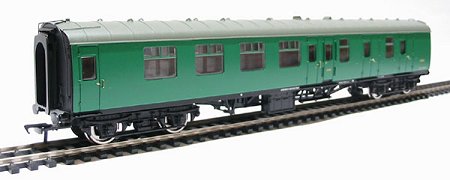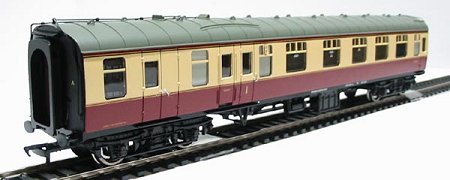Review of Bachmann 4mm Scale BR MkI 64ft Coaches and others
| BR MkI coaches have been on the market for a number of
years now this review centres around those available at the time of writing,
namely Bachmann and Hornby. Versions have in the past also been available from
Lima and Replica and these can often be found on the second-hand market.
Prototype information on the BR MkI coaches can be found here. The Southern Region ran the majority of its BR MkI coach stock in fixed sets, as did to a certain extent Network SouthEast for services on former Southern lines. Information of these sets can be found here. The latest Bachmann versions are in the reviewer's opinion streets (or should that be rails) ahead of the other manufacturers' versions, and are probably the best ready to run coaches on the market today.
|
|||||||||||||||||||
 |
| Bachmann MkI SO on Commonwealth bogies |
| Bachmann The models capture the prototypes really well. The glazing is wonderfully flush with no smoking signs applied where appropriate. They are well detailed and have some nice touches such as separate water tank filler pipes, and end handrails rather than moulded. Door handles and handrails are not separate, except in the case of the guards handrails on the BSK, but are very neatly picked out in brass. Exterior printing is to a very high standard. It includes data panels on the coach ends and inscriptions on the edge of the chassis frame as well as numbers and lining as appropriate. The types of bogies fitted are varied depending on the livery of the model with the earlier period B1 bogie or the Commonwealth bogie as fitted on the prototypes built in the late 1950s. The reviewer is not aware of Bachmann modelling the later B4 bogies which whilst not fitted to many MkIs when new was retrofitted to replace worn out B1 bogies. A bag of add-on parts provides a buckeye coupler in its dropped position and an alternative coupling shaped as pipework to replace the tension lock couplings between adjacent coaches if the coaches are being used in fixed sets. The brake coaches are supplied also with a corridor tailboard complete with tail lamp. The chassis features a number of mounting holes to allow factory fitting of chassis equipment in the correct positions. |
 |
| Bachmann MkI BSK on B1 bogies |
| One negative would be that the roof section panel join
lines are too pronounced for many coach aficionados. As for running, there has been mixed reports some have experienced problems especially with derailments on reverse curves. The spring that centres the close coupling arm seems a little too stiff leading to derailments when entering/leaving curves and modellers may need to consider reducing the tension of the spring somehow. It is recommended, by the reviewers, ensuring that the bogie pivot point and close coupling arrangement that surrounds the pivot point are kept lubricated. For long rakes it has also been suggested that some of the coaches in the rake have their weights removed as they are quite weighty and may cause haulage problems for some locomotives especially on a layout. The Bachmann slim line couplings are in NEM pockets on a close coupling arm acting around the bogie pivot point to open up the gap on curves and close the gap on straights which does appear to work to keep the moulded corridor connectors extremely close. These slimline couplings can be easily replaced with a KadeeNº20 buckeye coupling which is a direct fit into the NEM pocket and enhances the look and operation considerably. Though the Kadees may not be at the recommended height according to the Kadee height gauge. |
 |
| Bachmann MkI CK on Commonwealth bogies |
| Taking it apart! While Bachmann have provided a number of features previously missing on ready to run models the interior is still missing a number of 18-24mm high features - passengers! Firstly unscrew the bogies and reveal the sprung mechanism for the close-coupling system. Move each of these mechanisms to one side and unscrew the screw that is revealed; also unscrew the screw in the centre of the chassis. Now carefully release the roof pipework from the roof and the chassis should now easily fall away from the body. The interior is now contained in a three-sided tube formed by the sides and roof to which they are clipped. Gently ease the sides apart and slide the interior moulding out. Detail the interior moulding and reassemble. At all times be careful not to push on the windows as they are individually glued in position. |
 |
| Bachmann MkI BCK on B1 bogies |
| Hornby These coaches are of Triang heritage and were first introduced around 1963 to replace the non-scale length ("shorty") MkIs from the same manufacturer. They have recently been substantially improved including flush glazing and the removal of the moulded bodyside ribs that were there as a paint barrier for two colour (crimson/cream, blue/grey) liveries when paint application methods were less sophisticated than today. They are, however still light on roof and underframe detail and the underframe is generic rather than accurate for any particular type of MkI The bogies fitted to all versions are of the earlier B1 type rather than the Commonwealth bogie fitted on the prototypes built after the late 1950s. The traditional Hornby tension lock couplings, are fitted mounted on the bogies, are not of the close coupling type. |
 |
| Hornby MKI BSK |
| Replica These coaches were "semi" flushglazed so the depth of the window frames was considerably more pleasing than the prevailing offerings. Detailing was also generally of a finer standard. In many senses these coaches were a "halfway house" between the Hornby and Lima MkIs and the more recent Bachmann versions. The examples seen by the reviewer have been fitted with Commonwealth bogies. |
 |
| Hornby MKI CK |
| Lima Deep non-flush glazed windows are the first obvious drawback with the Lima models. Like the Hornby versions they are very light on roof and underframe detail both of which are generic rather than accurate for any particular type of MkI. The bogies are a slightly undersize version of the B4 style, which whilst not fitted to many MkIs when new was retrofitted to replace worn out B1 bogies and are therefore incorrect for early versions of the MkI. They are fitted coarse deep-flanged wheels, as per most of Lima's models at the time, which will not run on Code 75 track without the flanges fouling the chairs. Replacement wheel sets are available from both Romford/Markits and Alan Gibson but you must specify that they are for Lima models, as the axle length is shorter. The ride height of the body on the bogies is high with a considerable gap between the coach floor and the top of the bogies. Taking it apart! |
 |
| Hornby MKI RMB |
| Text supplied by: Graham R 'Muz' Muspratt Colin Duff Tony Walmsley |
All photographs are copyright Graham R 'Muz' Muspratt
return to model railway product reviews index
This page was created 1 July 2004